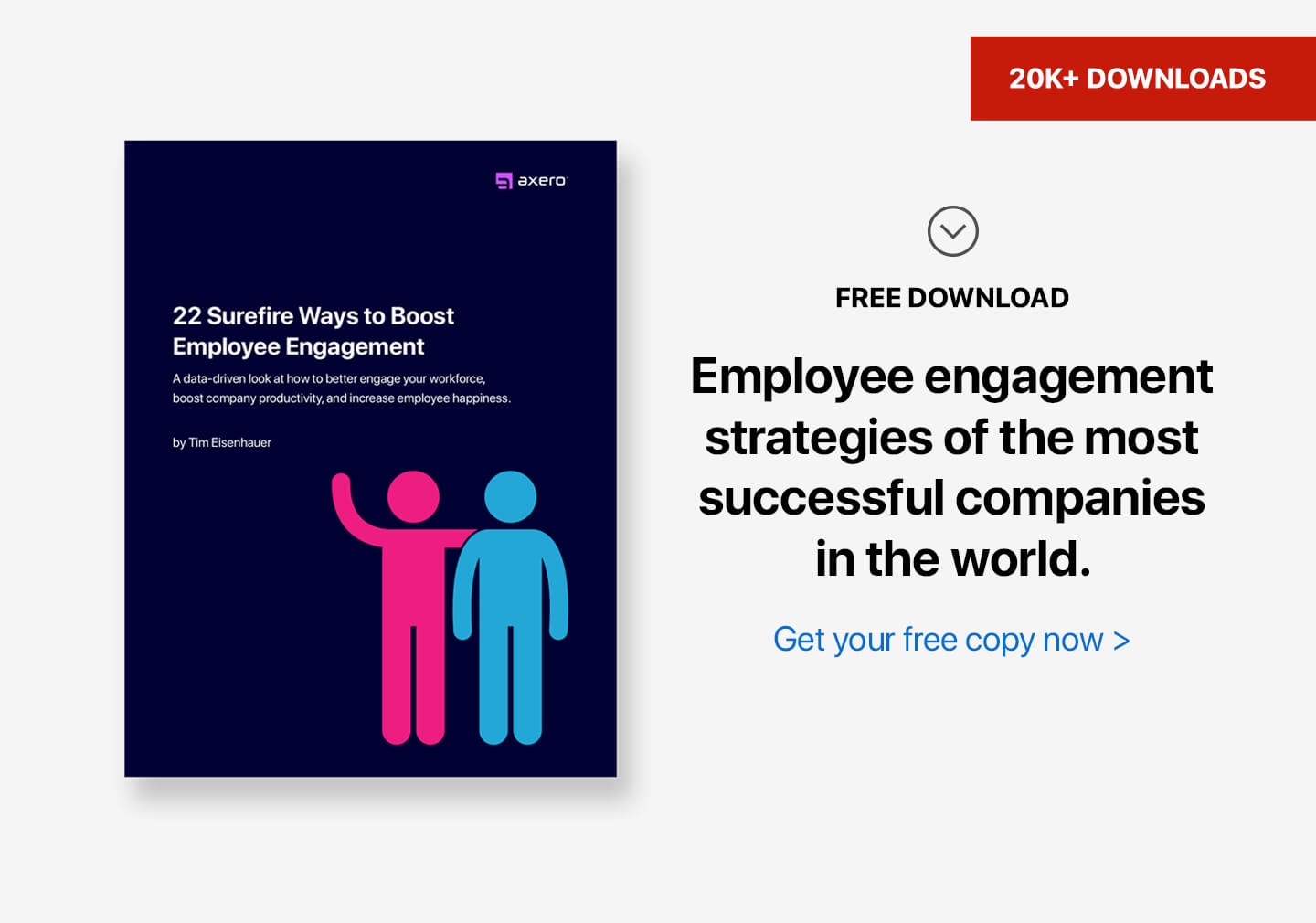Attention HR leaders! Are you looking for a cheap perk that means everything to a large portion of your workforce and prospective hires? Here’s an idea: let them bring their pets to work.
Pet-friendly workplaces are the most recent maneuver in the war for talent. Employers that allow pets in the office report additional benefits, like reducing stress and making people friendlier, but the main draw is obvious: once employees get used to taking their dogs to work, they’ll have a hard time leaving them at home. Hence they’ll think twice about switching jobs.
Office pets are still a novelty and are sure to make an impression on job candidates—one way or the other. The Society for Human Resource Management (SHRM) reported that in 2017 only 8 percent of employers offered this perk. But you might be surprised to find many household names among them. Aside from pet food companies, like PetSmart and Nestlé Purina, the list includes Ticketmaster, Amazon, Google, Salesforce, Zoosk, Etsy, Kimpton Hotels, Advent Software, Ben & Jerry’s, HubSpot, Zynga, and Clif Bar & Company, to name a few.
The vast majority of the pets employers allow—and employees choose—to bring to work are dogs. That’s where you get the most bang for your buck, since other house animals don’t require daily walks. But there are exceptions. Not to be outdone by any competitor, inbound marketing provider HubSpot will ban no animal species from its premises:
“We believe in healthy, productive, and happy employees. And we’re committed to this—even if that means anteaters roaming the halls, parrots nesting in the kitchen, or awkward turtles in our marketing meetings. In short, HubSpotters won’t need to leave behind the fuzzy, furry, or scaly companions that inspire them. We’ve decided to let HubSpotters around the globe bring their pets to work. Let freedom ring… or squawk… or meow… or growl.” 1
The blog goes on to list the array of animals that report to HubSpot to inspire the human staff. Here they are, along with their special talents:
- Chickens – “Two words that brighten up any employee’s morning: fresh omelets.”
- Sheep – “Office temps give you an occasional case of the chills? Warm up alongside nature’s sweater.”
- Goats – “Your own personal, on-demand paper shredder and facial hair consultant.”
- Kangaroo – “The utility vehicle of office pets. Carry around laptops, pens, and notebooks—all while keeping your lunch warm.”
- Anaconda – “Monday vibes give you the blues? Nothing a nice, strong hug can’t fix.”
- Octopus – “Manage all your daily tasks and more with a helping hand. Bonus: Fresh ink for the quill.”
- Alpaca – “Ever spill coffee during the morning hustle? Clean it up with a real alpaca-spit shine.”
- Elephant – “How long before the joke, ‘I want to address the elephant in the room,’ gets old? Time to find out.”
- Pig – “Stay-the-course on any diet. This office pet will eat every tasty treat in sight before you can.”
Letting your marketing assistant bring her Yorkie to work doesn’t sound so extreme now, does it?
So, what’s the bigger picture here? Are office pets a distracting fad, like open floor plans, or a new normal? History has yet to render a definitive verdict, but here’s what we know so far.
It all started in 1999. Inspired by the success of Take Your Daughter to Work Day, Pet Sitters International (PSI) launched Take Your Dog to Work Day. Rather than prompting dogs to think about their future careers, PSI hoped to promote dog ownership and adoption among working adults. About 300 US companies signed up the first year. As the word spread, more participated annually, and some let the dogs come back every day. In 2015, the number of pet-friendly workplaces reached 8 percent of the total, and it has hovered around that figure for the last three years.
How is it working out?
According to official sources, Amazon, which welcomes more than 6,000 dogs daily into its Seattle headquarters, couldn’t be happier:
“Amazon points to the employee experience as the main consideration with its dog-friendly policy. Dogs have been central to Amazon’s workplace for about 20 years, with a Welsh corgi named Rufus even ceremoniously clicking the mouse to launch some of Amazon.com’s first pages.” 2
Harpoon Brewery employs roughly 300 people and allows dogs in the office—but not where the beer is stored and served. The practice started with a dog or two showing up at its Vermont facility. It worked so well to defuse the stressful, fast-paced, and physically demanding atmosphere at the brewery that the company encouraged employees at the Boston office to do the same:
“Productivity did not go down, but blood pressure certainly did and from there we ended up with three, four, seven dogs coming in at a time,” said Chris Bonacci of Harpoon Brewery. He said it wasn’t a vision they had planned for the company, but a natural progression starting with the CEO who loves dogs, and people bringing them along to work.” 3
Despite all the enthusiasm, there’s an obvious downside to dogs in the workplace. Barking, dog fights, “accidents,” kicked over trash cans, biting, a dislike or fear of dogs… Some of the objections are a nuisance factor ranging somewhere in between a noisy coworker and a toxic boss. Others, like pet allergies, are legal matters. As Chas Rampenthal, General Counsel of LegalZoom, puts it, “For some people, being near a pet is the equivalent of being underwater—they just can’t breathe.”
This scenario was the subject of one of Alison Green’s Ask a Manager blog posts:
“[S]omeone . . . went to work in an office that was dog-friendly and a bunch of people brought their dogs in and she had debilitating allergies. The company did not want to work with her on it and legally they had to accommodate her. But people were pissed. People felt like they had come to the company specifically because it was dog-friendly and she was ruining it. It became a very hostile environment for her. She ultimately had to leave over it because there was such a huge clash of her interest against their interests. You can kind of see where they are coming from too—it’s their culture.” 4
The company in question was able to settle the dispute amicably. The employees got to keep their dogs, and the injured party got a payout and a new job—but not without a lot of turmoil and lawyers on both sides. Not exactly what Purina had in mind when it reported that 80 percent of employees in pet-friendly workplaces felt “happy, relaxed and sociable” around office pets. Watch out for those 20 percent!
Absent allergies and phobias, having a dog nearby may lower your stress. But what about the dog? Can you tell if the dog is excited about coming to work or nervous and confused? Here’s one expert’s opinion:
“’Most people do not understand dog body language,’ said E’Lise Christensen, a board-certified veterinary behaviorist in Colorado. … Coworkers might interpret the panting of a dog in the office as a friendly smile, rather than a sign of nervousness. And in dogs, nervousness can lead to bites. ‘[People] can identify abject fear, and they can identify extreme aggression, but they cannot reliably identify things in between,’ said Christensen. It’s in that wide middle area where we may not recognize pet discomfort.” 5
Bonnie Beaver, executive director of the American College of Veterinary Behaviorists and a professor at Texas A&M University, doesn’t see many reasons for a dog to fancy office life:
“Generally, dogs are expected to sit still in an office setting, which can be difficult for active dogs, leading to boredom (which, in turn, leads to problem behaviors like chewing up desk legs) …” 5
Sounds just like our college interns.
“These policies are also particularly hard on dogs if they’re taken to the office only occasionally, instead of regularly; dogs are big on routines, and uncertainty adds to their fear and stress.” 5
Moment of truth: are you still tempted to let pets inside your company?
PSI touts Take Your Dog to Work Day as a perfect opportunity to test-drive the idea. But not everyone agrees. Jennifer Fearing, co-author of “Dogs at Work: A Practical Guide to Creating Dog-Friendly Workplaces,” advocates for having a detailed policy in place before letting a single dog through the doors:
“[W]orkplaces should consider nuanced protocols before implementing a dog-friendly environment … If a dog shows aggression or bites a person or another dog, the animal won’t be allowed back to the office, for example, and each dog will need to be up-to-date on their shots … The careful implementation of these rules and policies is how a dog-friendly workplace can be productive and efficient … That’s why Take Your Dog to Work Day terrifies Fearing. ‘It’s mayhem … That’s not what dog-friendly workplaces look like.’” 6
In fact, every company that bills itself as pet-friendly abides by some form of “petiquette” to mitigate the risks of hosting an animal. As with human employees, anticipating your dog’s habits and basic needs is the best way to keep the workplace peaceful and productive.
Many companies limit the size and breed of the dogs they allow. At the very least, ask your employees to monitor how their dogs get along with other dogs and humans. Make sure they report any changes. Have owners take the dogs out regularly for bathroom breaks—or leave the dog at home on days when they are tied up in meetings. Remind employees to never leave food on the desks or in the trash bins so the dogs won’t eat it. Here’s more detailed advice from Jennifer Fearing:
“Other steps could include requiring a dog’s bedding to be washed once a week, as well as the implementation of HEPA filters to provide allergy relief. Additionally, sections or floors of a workplace should be determined as no-dog-zones, and employees taking their dogs to their desks should take the shortest route possible to get there.”
Finally, don’t forget to CYA from legal liability. Chas Rampenthal recommends requiring employees to carry pet owner insurance to cover personal injury and property damage to other employees, customers, or delivery guys. (Is it a perk, if you make them pay for it?) If you rent office space, check your lease agreement and make sure the landlord is okay with pets. Allergies could be a trickier subject. Rampenthal explains:
“An animal allergy may be considered a disability under the Americans with Disabilities Act of 1990. If so, you as an employer are expected to make reasonable accommodations to any employees who request such; otherwise you risk an ADA violation. The jury is still out on this one, especially when one employee needs to have a service dog and another employee has a horrible allergic reaction to dogs.” 7
Larger employers, like Amazon, seem to get around this problem by keeping pets and those allergic to them on separate floors, buildings, and building areas. Ask employees what they are allergic to (the list just keeps getting longer). If you can’t provide dog-free workspace, be sure to mention this fact during the job interview.
You may change your mind about letting pets in after you consult your legal eagles. After all, it’s their job to scare you out of having any fun. Still want to do something for pet owners? Here are a few options:
A virtual pet gallery.
If your employees can’t bring their beloved pets to work, they could at least share photos and videos of them and exchange stories and advice. Imagine an Instagram-like site solely dedicated to office pets. That’s what the pharmaceutical giant Genentech did with gDOGs, an employee resource group for dog owners. With life science intranet software, you can easily create one too on your very own social intranet!
Pet happy hours.
Why not socialize with coworkers and their pets outside of work? Your company could sponsor pet-friendly events to help employees relax and bond over their life’s passion.
Pet health insurance.
According to SHRM’s 2017 benefits survey, 10 percent of employers offer this benefit, including a third of Fortune 500 companies, and the number is growing. Helping out with the rising cost of pet care will make your company more competitive in the eyes of pet owners.
Pet adoption and bereavement leave.
Being pet-friendly means helping employees deal with arrival and loss of a pet—both major life changes, especially now that pets have become surrogate spouses and children for many owners. Policies vary from paid time off to allowing employees to work remotely for a week or so after they bring home a new pet.
Bottom line: a pet-friendly policy is another “wacky” employee engagement idea that can succeed or backfire spectacularly. Beware of copycat tactics. Listen to your people and do what makes sense for you.
—–
If you like trying new things, you might like my book, because it helps you succeed on the first try.
—–
SOURCES
[1] “Introducing HubSpot’s #PETprogram: Taking ‘Office Dogs’ to a Whole New Level” by Orlando Scampington, hubspot.com blog https://blog.hubspot.com/marketing/introducing-the-pet-program
[2] “Why Bringing Your Dog to Work Can Be Great for (Almost) Everyone” by Jennifer Calfas, Time, June 22, 2018
[3] “More US Companies Allowing Employees to Bring Dogs to Work” by Cassy Arsenault, necn.com, August 2, 2018 https://www.necn.com/news/business/More-Companies-Allowing-Employees-to-Bring-Dogs-to-Work-489922521.html
[4] “Awkward! The blog to ease that horrible office conversation no one wants to have” by Jana Kasperkevic, the Guardian, December 2016
https://www.theguardian.com/business/2016/dec/24/ask-a-manager-blog-workplace-advice-allison-green
[5] “Don’t Bring Your Dog to Work” by Matt Miller, Slate, August 15, 2016
https://slate.com/technology/2016/08/pet-friendly-offices-often-dont-consider-whether-it-works-for-the-pets.html
[6] “Why Bringing Your Dog to Work Can Be Great for (Almost) Everyone” by Jennifer Calfas, Time, June 22, 2018 http://time.com/5186237/dogs-at-work-benefits/
[7] “But Is It Legal? Dogs in the Office” by Chas Rampenthal, Inc., August 16, 2012
https://www.inc.com/chas-rampenthal/dogs-in-the-office-is-it-legal.html












 info@axerosolutions.com
info@axerosolutions.com 1-855-AXERO-55
1-855-AXERO-55


